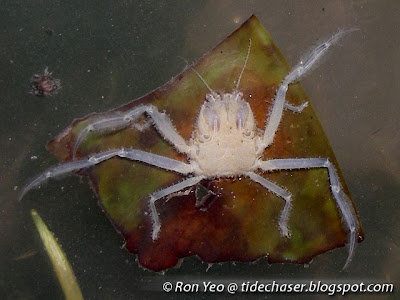Porter crabs (phylum Arthropoda, subphylum Crustacea, class Malacostraca, order Decapoda, superfamily Dorippoidea, family Dorippidae) are often not easy to spot on the seashore, as they usually camouflage themselves by carrying a leaf, broken shell, sea urchin, sea anemone or other small items (both living and non-living) on their back.

Without the item they are carrying, porter crabs can be recognised by their last two pairs of legs, which are oriented upwards for carrying things instead of downwards for walking. The carapace is usually somewhat trapezoidal, with the front margin narrower than the rear margin. They are mostly scavengers.
Like other true crabs, porter crabs have a broad carapace, and a very short and flattened abdomen which is usually folded underneath the body. They also have five pairs of "legs" (including the clawed arms, or chelipeds), and hence they are placed in the order Decapoda ("deca" means "ten", while "poda" means "feet"). The gills are leaf-like - a distinctive characteristic of decapods from the suborder Pleocyemata. And as with other crustaceans from the class Malacostraca, their body comprises three main parts - a head with five segments, a thorax with eight segments, and an abdomen with six segments. The head is fused to the thorax, forming a cephalothorax. They have a tough exoskeleton strengthened with calcium carbonate, and the carapace covers the gills but not the abdomen.
Porter crabs reproduce sexually, and have separate sexes. They mate face-to-face, usually with the male on top and the female below. The females can usually be distinguished from the males by having a broader abdomen. This is an adaptation to allow them to carry the eggs under their abdomen until they hatch.
I have only personally seen one species of porter crab in the wild in Singapore, though several species have been recorded by scientists.

The Leaf Porter Crab (Neodorripe callida) does not only carry leaves, but various other items on their back for camouflage purposes. In the photo above, the crab was carrying a sand dollar.

Sometimes, Leaf Porter Crabs can also be seen swimming upside-down near the water surface, with the leaf they are carrying facing downwards, appearing just like a floating debris when viewed from below!

This species can be distinguished from the other species recorded from Singapore by having a carapace that is distinctively longer than broad. The other species recorded so far from Singapore have broader than long carapaces.
References

Without the item they are carrying, porter crabs can be recognised by their last two pairs of legs, which are oriented upwards for carrying things instead of downwards for walking. The carapace is usually somewhat trapezoidal, with the front margin narrower than the rear margin. They are mostly scavengers.
Like other true crabs, porter crabs have a broad carapace, and a very short and flattened abdomen which is usually folded underneath the body. They also have five pairs of "legs" (including the clawed arms, or chelipeds), and hence they are placed in the order Decapoda ("deca" means "ten", while "poda" means "feet"). The gills are leaf-like - a distinctive characteristic of decapods from the suborder Pleocyemata. And as with other crustaceans from the class Malacostraca, their body comprises three main parts - a head with five segments, a thorax with eight segments, and an abdomen with six segments. The head is fused to the thorax, forming a cephalothorax. They have a tough exoskeleton strengthened with calcium carbonate, and the carapace covers the gills but not the abdomen.
Porter crabs reproduce sexually, and have separate sexes. They mate face-to-face, usually with the male on top and the female below. The females can usually be distinguished from the males by having a broader abdomen. This is an adaptation to allow them to carry the eggs under their abdomen until they hatch.
I have only personally seen one species of porter crab in the wild in Singapore, though several species have been recorded by scientists.

The Leaf Porter Crab (Neodorripe callida) does not only carry leaves, but various other items on their back for camouflage purposes. In the photo above, the crab was carrying a sand dollar.

Sometimes, Leaf Porter Crabs can also be seen swimming upside-down near the water surface, with the leaf they are carrying facing downwards, appearing just like a floating debris when viewed from below!

This species can be distinguished from the other species recorded from Singapore by having a carapace that is distinctively longer than broad. The other species recorded so far from Singapore have broader than long carapaces.
References
- Carpenter, K. E. & V. H. Niem (eds), 1998-2001. FAO species identification guide for fishery purposes. The living marine resources of the Western Central Pacific. Volumes 1 to 6. FAO, Rome. pp. 1-4218.
- De Grave, S., N. D. Pentcheff , S. T. Ahyong, T.-Y. Chan, K. A. Crandall, P. C. Dworschak, D. L. Felder, R. M. Feldmann, C. H. J. M. Fransen, L. Y. D. Goulding, R. Lemaitre, M. E. Y. Low, J. W. Martin, P. K. L. Ng, C. E. Schweitzer, S. H. Tan, D. Tshudy & R. Wetzer. 2009. A classification of living and fossil genera of decapod crustaceans. The Raffles Bulletin of Zoology, supplement 21, pp. 1-109.
- Debelius, H. 1999. Crustacea - Guide of the world. IKAN, Frankfurt. 321pp.
- ETI BioInformatics. 2012. Marine species identification portal. Retrieved Jul 8, 2013, from http://species-identification.org.
- Ng, P. K. L., L. K. Wang & K. K. P. Lim (eds.). 2008. Private lives: An exposé of Singapore’s mangroves. Raffles Museum of Biodiversity Research, Department of Biological Sciences, National University of Singapore. 240 pp.
- World Register of Marine Species. 2012. Retrieved Jun 10, 2013, from http://www.marinespecies.org.

No comments:
Post a Comment